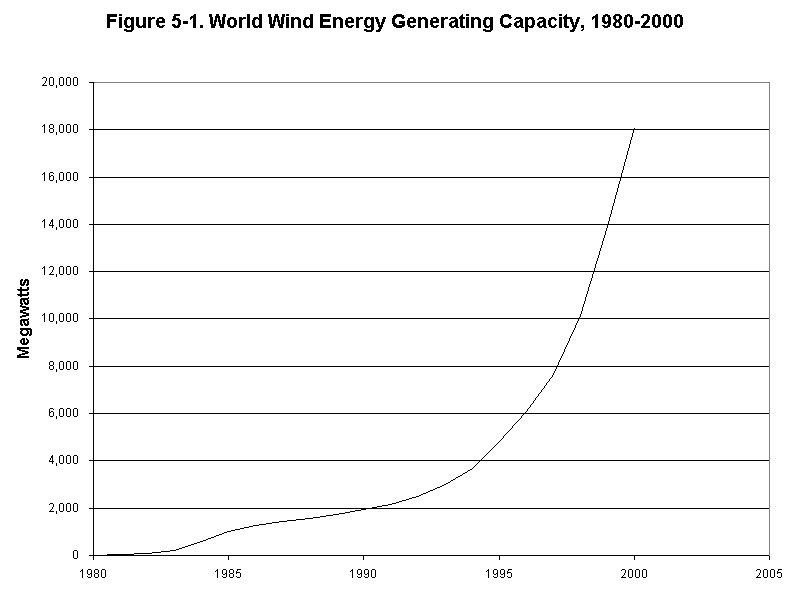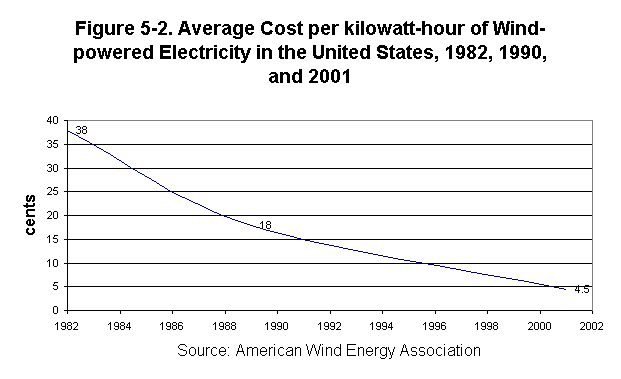Did you know? A bicycle is a marvel of engineering efficiency, one where an investment in 22 pounds of metal and rubber boosts the efficiency of an individual mobility by a factor of three. On my bike I estimate that I get easily 7 miles per potato. For more information view the text and data in Chapter 6 of Plan B 4.0: Mobilizing to Save Civilization.
Chapter 5. Building the Solar/Hydrogen Economy: Harnessing the Wind
The modern wind industry was born in California in the early 1980s in the wake of the oil price hikes of 1973 and 1979. Under the leadership of Governor Jerry Brown, the state added its own tax incentive to an existing federal one to develop renewable energy resources, creating an investment climate that yielded enough wind-generating capacity statewide to satisfy the residential needs of San Francisco. But after a fast beginning in California, U.S. interest in wind energy lagged, almost disappearing for a decade.22
While interest in wind energy was sagging in the United States, it was continuing to advance in Europe, led initially by Denmark, which had built many of the wind turbines that were installed in California. From 1995 to 2000, as noted earlier, wind energy worldwide expanded nearly fourfold, a computer industry growth rate. (See Figure 5-1.) And the United States got back into the race, with AWEA projecting 60 percent growth in U.S. wind generating capacity in 2001.23
Today Denmark gets 15 percent of its electricity from wind power. For Schleswig-Holstein, the northernmost state of Germany, the figure is 19 percent—with some parts of that state getting an impressive 75 percent. Spain's industrial state of Navarra, starting from scratch six years ago, now gets 22 percent of its electricity from wind. But in terms of absolute generating capacity, Germany has emerged as the world leader, with the United States in second place. (See Table 5-1.) Spain, Denmark, and India round out the top five.24
Advances in wind turbine technology, drawing heavily on the aerospace industry, have lowered the cost of wind power from 38¢ per kilowatt-hour in the early 1980s to less than 4¢ in prime wind sites in 2001. (See Figure 5-2.) In some locations, wind is already cheaper than oil or gas-fired power. With major corporations such as ABB, Royal Dutch Shell, and Enron plowing resources into this field, further cost cuts are in prospect.25
Wind is a vast, worldwide source of energy. The U.S. Great Plains are the Saudi Arabia of wind power. Three wind-rich states—North Dakota, Kansas, and Texas—have enough harnessable wind to meet national electricity needs. China can double its existing generating capacity from wind alone. Densely populated Western Europe can meet all its electricity needs from offshore wind power out to an ocean depth of 30 meters.26
As wind generating costs fall and as concern about climate change escalates, more and more countries are climbing onto the wind energy bandwagon. Beginning in December 2000, the scale of world wind energy development climbed to a new level. Early in the month, France announced it will develop 5,000 megawatts of wind power by 2010. Later in the month, Argentina announced a plan to develop 3,000 megawatts of wind power in Patagonia by 2010. Then in April 2001, the United Kingdom accepted offshore bids for 1,500 megawatts of wind power. In May, a report from Beijing indicated that China plans to develop some 2,500 megawatts of wind power by 2005.27
The actual growth in wind power is consistently outrunning earlier estimates. The European Wind Energy Association, which in 1996 had set a target of 40,000 megawatts for Europe by 2010, recently upped its goal to 60,000 megawatts.28
In the United States, wind power was once confined to California, but during the last three years wind farms coming online in Colorado, Iowa, Minnesota, Oregon, Pennsylvania, Texas, and Wyoming have boosted U.S. capacity by half—from 1,680 megawatts to 2,550 megawatts. (One megawatt of wind generating capacity typically supplies 350 homes.) The 1,500 or more megawatts to be added in 2001 will be located in a dozen states. A 300-megawatt wind farm under construction on the Oregon/Washington border, currently the world's largest, can supply 105,000 homes with electricity.29
But this is only the beginning. The Bonneville Power Administration (BPA), a U.S. federal agency power supplier, indicated in February that it wanted to buy 1,000 megawatts of wind-generating capacity and requested proposals. Much to its surprise, it received enough proposals to build 2,600 megawatts of capacity in five states, with the potential of expanding these sites to over 4,000 megawatts. BPA, which may accept most of these proposals, expects to have at least one site online by the end of 2001.30
A 3,000-megawatt wind farm in the early planning stages in east central South Dakota, near the Iowa border, is 10 times the size of the Oregon/Washington wind farm. Named Rolling Thunder, this proposed project—initiated by Dehlsen Associates and drawing on the leadership of Jim Dehlsen, a wind energy pioneer in California—is designed to feed power into the Midwest around Chicago. It is not only large by wind power standards, it is one of the largest energy projects of any kind in the world today.31
Income from wind-generated electricity tends to remain in the community, bolstering local economies by providing local income, jobs, and tax revenue. One large advanced-design wind turbine, occupying a quarter-acre of land, can easily yield a farmer or rancher $2,000 in royalties per year while providing the community with $100,000 of electricity.32
For farmers and ranchers, discovering the value of their wind resources is like striking oil--except that the wind is never depleted. One of wind's attractions is that the turbines scattered about a farm or ranch do not interfere with the use of the land for farming or cattle grazing. For ranchers with prime wind sites, income from wind can easily exceed that from cattle sales. The wind boom can rejuvenate rural communities throughout the world.
Once we get cheap electricity from wind, we can use it to electrolyze water, splitting the water molecule into its component elements of hydrogen and oxygen. Hydrogen is the simplest of fuels and, unlike coal or oil, is entirely carbon-free. It is the fuel of choice for the new, highly efficient fuel cell engine on which every major auto manufacturer is now working. DaimlerChrysler plans to market fuel cell-powered cars by 2003. Ford, Toyota, and Honda will probably not be far behind.33
Surplus wind power can be stored as hydrogen and used in fuel cells or gas turbines to generate electricity, leveling supply when winds are variable. Wind, once seen as a cornerstone of the new energy economy, is likely to become its foundation.
With the advancing technologies for harnessing wind and powering motor vehicles with hydrogen, we can now see a future in which U.S. farmers and ranchers supply not only much of the country's electricity, but much of the hydrogen for its fleet of automobiles as well. For the first time, the United States has the technology to divorce itself from Middle Eastern oil.
Within the United States, a new lobby is developing for wind power. In addition to the wind industry and environmentalists, U.S. farmers and ranchers are now also urging lawmakers to support development of this abundant alternative to fossil fuels.34
In manufacturing the turbines that convert wind into electricity, Denmark is the world leader. Sixty percent of all the turbines installed in 2000 were either manufactured by Danish companies or licensed by them. This illustrates how a country can translate foresight and a strong environmental commitment into a dominant position in the fast-emerging eco-economy. The United States, although now experiencing an extraordinary growth in wind energy development, is struggling to get back into the race in the manufacturing of wind energy turbines. The first utility-scale wind turbine manufacturing facility to be built in the United States outside of California has recently started operation in Champaign, Illinois, in the heart of the Corn Belt.35
The world is beginning to recognize wind for what it is—an energy source that is both vast and inexhaustible, an energy source that can supply both electricity and hydrogen for fuel. In the United States, farmers are learning that two harvests—crops and energy—are better than one. Political leaders are realizing that harnessing the wind can contribute to both energy security and climate stability. And consumers opting for green electricity are learning that they can help stabilize climate. This is a winning combination.
| Table 5-1. Wind Energy Generating Capacity in Selected Countries, 2000 | ||||||||||||||
|
||||||||||||||
| Source: See endnote 24. |


ENDNOTES:
22. Colin Woodard, "Wind Power Pays Well for Denmark," San Francisco Chronicle, 23 April 2001; Peter Asmus, Reaping the Wind (Washington, DC: Island Press, 2000).
23. Figure 5-1 from Flavin, op. cit. note 3; AWEA, op. cit. note 3.
24. Denmark from Christopher Flavin, Worldwatch Institute, Vital Signs 2001 press briefing, Washington, DC, 24 May 2001; Germany from AWEA, Wind Energy Press Background Information (Washington, DC: February 2001), and from Christian Hinsch, "Wind Power Flying Even Higher," New Energy, February 2001, pp. 14-20; information on Navarra from Felix Avia Aranda and Ignacio Cruz Cruz, "Breezing Ahead: The Spanish Wind Energy Market," Renewable Energy World, May-June 2000; Table 5-1 from AWEA, Global Wind Energy Market Report 2000, www.awea.org/faq/global2000.html, viewed 25 June 2001.
25. Cost reduction history from Glenn Hasek, "Powering the Future," Industry Week, 1 May 2000; Figure 5-2 from Flavin, op. cit. note 3.
26. According to AWEA, Texas, North Dakota, and Kansas would be able to produce 3,470 billion kilowatt-hours (kWh), exceeding the 3,087 billion kWh used by the United States in 2000, as reported by DOE, EIA; AWEA, AWEA Wind Energy Projects Database, www.awea.org/projects/ and EIA Country Analysis Brief, DOE, www.eia.doe.gov/emeu/cabs/usa.html. According to Debra Lew and Jeffrey Logan, "Energizing China's Wind Power Sector," Pacific Northwest Laboratory, 2001, www.pnl.gov/china/ChinaWnd.htm, China has at least 250 gigawatts of exploitable wind potential, roughly equal to the current installed electrical capacity in China as reported by EIA.
27. Dominique Magada, "France Sets Ambitious Target for Renewable Power," Reuters, 10 December 2000; Argentina from "Under Spanish Proposal, 15 Percent of Total Would be Eolic Energy," Agencia EFE, 7 February 2001; "UK Makes Leap into Offshore Wind Big Time," Renewable Energy Report (Financial Times), May 2001; "China Sets Wind Power Development," Asia Pulse, 19 October 2000.
28. European Wind Energy Association, "Wind Energy in Europe," www.ewea.org/src/europe.htm.
29. AWEA, "US Installed Capacity (MW) 1981-2001," www.awea.org/faq/instcap.html, viewed 25 June 2001; families powered per megawatt based on Louise Guey-Lee, "Forces Behind Wind Power," in DOE, EIA, Renewable Energy 2000: Issues and Trends (Washington, DC: February 2001), and on Don Hopey, "Wind Turbines to be Installed Near Pennsylvania Turnpike," Pittsburgh Post-Gazette, 24 April 2001; "World's Largest Wind Plant to Energize the West," PacifiCorp and FPL Energy, press release (Salt Lake City, UT, and Juno Beach, FL: 10 January 2001).
30. George Darr, "Astonishing Number of Wind Proposals Blows into BPA," Bonneville Power Administration, press release (Portland, OR: 26 April 2001).
31. Jim Dehlsen, Clipper Wind, discussion with author, 30 May 2001.
32. Lester R. Brown, "U.S. Farmers Double-Cropping Corn and Wind Energy," Earth Policy Alert (Washington, DC: Earth Policy Institute, 7 June 2001).
33. "DaimlerChrysler Unveils Fuel Cell Vehicle," Environmental News Network, 18 March 1999; "Honda Has New Fuel-Cell Car," op. cit. note 20.
34. "Corn Growers' Association Launches Education Program on Wind Power," Wind Energy Weekly (AWEA), 25 May 2001, p. 4.
35. "BTM Predicts Continued Growth for Wind Industry," Renewable Energy Report (Financial Times), May 2001, p. 8; figure of 60 percent is based on listed market shares of top wind turbine suppliers; Tom Gray, "Wind is Getting Stronger and is On Course for the Next Decade," Renewable Energy World, May 1999.
Copyright © 2001 Earth Policy Institute

